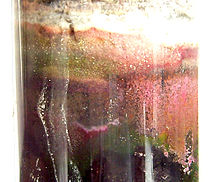Purple bacteria
Under the name of purple bacteria all obligate or facultative are phototrophic living proteobacteria summarized. They do not form a monophyletic group, but contain representatives from the classes of the alpha , beta and gammaproteobacteria . Her for the photosynthesis used pigments ( bacteriochlorophylls and carotenoids ) were name-giving, giving the purple bacteria a showy, usually reddish to reddish brown color. Older literature often uses the term “purple bacteria” synonymously for all proteobacteria. This is no longer common today.
The purple bacteria always carry out anoxygenic photosynthesis , in which, in contrast to the oxygenic photosynthesis of cyanobacteria and plants, no oxygen is produced. Purple bacteria are usually even obligate anaerobes . The bacteria only have one photosystem . For photosynthesis they therefore need electron donors whose redox potential is lower than that of water.
A distinction is made between sulfur purple bacteria and non-sulfur purple bacteria.
Sulfur purple bacteria

The purple sulfur bacteria are formed from the two families Ectothiorhodospiraceae and Chromatiaceae . They use hydrogen sulfide (H 2 S) or sulfide ions (S 2− ) instead of water (H 2 O) as an electron donor for the reduction of CO 2 , which is why no oxygen is released. When sulfide is oxidized, elemental sulfur is produced instead, which the bacteria deposit in the form of sulfur spheres inside the cell, in the periplasmic space or in the external medium (extracellular). Representatives of the Ectothiorhodospiraceae always deposit the sulfur spheres extracellularly, but the corresponding genus Thiorhodospira both intra- and extracellularly.
The stored sulfur can be further oxidized to sulfate by most species if there is a H 2 S deficiency. In addition to sulfide or elemental sulfur, many purple sulfur bacteria also use thiosulfate or hydrogen as electron donors for photosynthesis.
These bacteria are found in low-oxygen waters or low-oxygen water layers in lakes, but also in sulfur springs. With optimal H 2 S concentration and light intensity in certain layers of water or on the bottom of shallow water, purple sulfur bacteria can “bloom” and achieve high cell densities. Many species have intracellular gas vesicles , with the help of which they can stay in the water layers that are optimal for them without using much energy. Some species are extremely halophilic and, in addition to some archaea, give salt and soda lakes their striking reddish color.
Non-sulfur purple bacteria
The non-sulfur purple bacteria are physiologically very diverse. They always belong to the Alpha- or Betaproteobacteria and are able to carry out photosynthesis with various - including organic - compounds as electron donors. One finds the unusual metabolic type of photoheterotrophy here . Contrary to what their name suggests, many species can also use sulfide - a sulfur compound - as an electron donor for photosynthesis. The ability of phototrophic sulfide oxidation has long been overlooked because even low sulfide concentrations (<1 mM) are toxic to the bacteria. Some representatives are able to grow through breathing or fermentation if there is a lack of light . Most non-sulfur purple bacteria can fix nitrogen .
The purple bacteria are to be distinguished from the likewise phototrophic green sulfur bacteria and the thermophilic green non-sulfur bacteria .
Genera
Genera and some of the currently described species of purple sulfur bacteria (all belong to the Gammaproteobacteria ):
| genus | species | morphology |
|---|---|---|
| Allochromatium |
Allochromatium vinosum , Allochromatium minutissimum , Allochromatium warmingii |
short or long rods, polar flagellated |
| Amoebobacter | Amoebobacter purpureus | Inactively moving, irregularly shaped cocci to short rods, gas vesicles |
| Chromatium | Chromatium okenii , Chromatium weissei | short or long rods, polar flagellated |
| Ectothiorhodospira |
Ectothiorhodospira shaposhnikovii , Ectothiorhodospira mobilis , Ectothiorhodospira marina , Ectothiorhodospira haloalkaliphila |
flagellated, helical bacteria (spirilla) deposit sulfur outside the cell |
| Halochromatium | Halochromatium salexigens , Halochromatium glycolicum | extremely halophilic, short or long rods, polar flagellated |
| Halorhodospira |
Halorhodospira neutrophila , Halorhodospira halophila , Halorhodospira halochloris |
extremely halophilic spirils, deposit sulfur outside the cell |
| Isochromatium | Isochromatium buderi | short or long rods, polar flagellated |
| Lamprobacter | Lamprobacter modestohalophilus | Rods, gas vesicles |
| Lamprocystis | Lamprocystis roseopersicina | Cocci, short rods, polar, monotrich flagellated, gas vesicles |
| Marichromatium | Marichromatium gracile , Marichromatium purpuratum | short or long rods, polar flagellated |
| Rhabdochromatium | Rhabdochromatium marinum | short or long rods, polar flagellated |
| Thermochromatium | Thermochromatium tepidum | short or long rods, polar flagellated |
| Thiocapsa |
Thiocapsa roseopersicina , Thiocapsa rosea , Thiocapsa pendens |
Cocci, without active movement |
| Thiococcus | Thiococcus pfennigii | Cocci |
| Thiocycstis |
Thiocycstis gelatinosa , Thiocycstis minor , Thiocycstis violacea , Thiocycstis violascens |
Cocci, polar flagellated |
| Thiodictyon | Thiodictyon elegans , Thiodictyon bacillosum | Inactive rods with gas vesicles form net-like colonies on surfaces |
| Thiohalocapsa | Thiohalocapsa halophila | Cocci |
| Thiolamp Provum | Thiolamprovum pedioforme | irregular, contiguous cocci, gas vesicles |
| Thiopedia | Thiopedia rosea | Cocci, without active movement, gas vesicles |
| Thiorhodococcus | Thiorhodococcus minor | Cocci |
| Thiorhodovibrio | Thiorhodovibrio winogradskyi | Spirils |
| Thiospirillum | Thiospirillum jenense | Spirilla, polar flagellated |
Genera of the non-sulfur purple bacteria:
- Rhodobacter (polar flagellated rods, division by binary cleavage, also budding occurs in different species)
- Rhodocyclus (curved, 2 cells form a ring, spirilla-shaped cell aggregates also occur)
- Rhodoferax (curved rods)
- Rhodomicrobium (oval, thickness 1.0–1.2 µm, peritrich flagellated, forms about 0.2 µm thick cell threads, multiplication by budding at the ends of the cell threads)
- Rhodopila (cocci, acidophilic )
- Rhodopseudomonas, Rhodoplanes, Rhodobium (flagellated rods, division by budding)
- Rhodospirillum, Phaeospirillum, Rhodovibrio, Rhodothalassium, Roseospira, Rhodospira (polar flagellated spirilla)
- Rhodovulum ( egg to rod-shaped)
- Rubrivivax (curved rods)